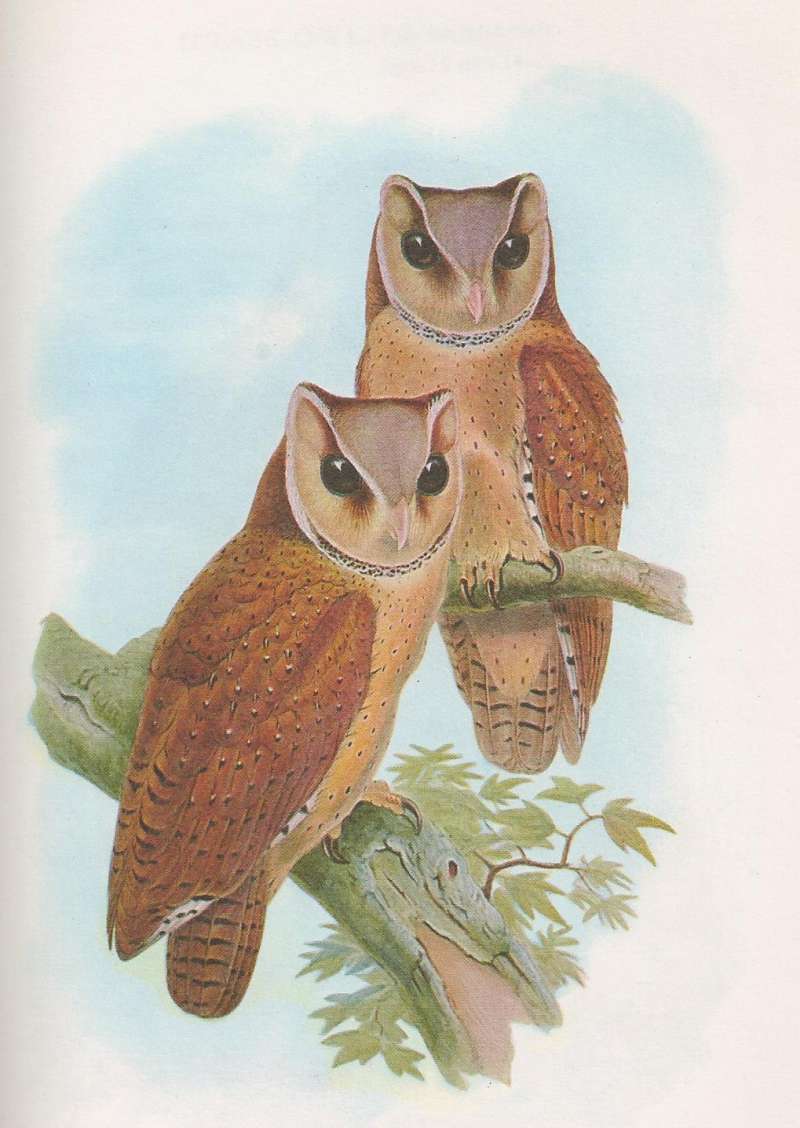SPECIES INFO
Bay owl (Phodilus badius) is found from northern India and Nepal south into Burma, Thailand, and Indochina. This is also recorded in the Philippines and Indonesia. This owl is also found rarely in India and more frequently in Sri Lanka (Ceylon). This 11 to 12 inch reddish-brownish owl has a pale pinkish face surrounded by a white and black ruff. The legs are feathered. The breast and back are marked with black spots. The wings have both dark spots and bars.
There are 6 subspecies. The nominate subspecies Phodilus badius badius is found widely from South East Asia (S. Burma and Thailand) south through Malaysia to Sumatra, Java, and Borneo. The subspecies saturatus is found from the Himalayas east across northern SE Asia to western China. The subspecies ripleyi is found in southwestern India. The subspecies assimilis is found in Sri Lanka (Ceylon). The subspecies parvus and arixuthus are insular and found on Belitung and Bungaran respectively.Bay owl genus (Phodilus) contains two species found in the Old World. One is a local species found in Africa and the other is a wide ranging Oriental species. These owls are from 9 to 13 inches in length.
Barn Owls (Family Tytonidae) are a group of 14 species. There are 12 species in the genus Tyto, and two species in the genus Phodilus. (Rob Hume in his 1991 book on Owls of the World counted 13 species in two genera.)
Owls (Order Strigiformes) are found worldwide. They are characterized by flexible feathers (for flying quietly), forward facing eyes, hunting at night for live prey, and swallowing their prey whole. There were 133 species of owls in books from about 1960. Clements in 2007 counted 199 based on many subspecies being raised to species status. Most students divide the owls into two families. However, the differences between the barn owls and regular owls is slight, and the Europeans tend to combine them all into a single family.
The outer toe is reversible permitting various methods of holding prey. In the sample claw images, the left set is for barn owls, the center set of claws is fishing owls, and the final set is typical owls.
Aves contains about 8,650 different species of living birds known to science. Each year about one new species is discovered in some remote rain forest or remote island. In addition, scientists have been raising many subspecies to full species status which may raise the species count to 10,000. Birdlife recognizes 10,027 species as of 2011.
However, each year about one species goes extinct. The rate of extinction is increasing, and the rate of new discovery is decreasing, so that the number of bird species will soon begin to decline rapidly. Although different taxonomists would organize the birds differently, there are approximately twenty-seven orders of birds. These orders are broken down into about one hundred and fifty-five different families.
Recent research of the genetic structure of some of the shore birds and owls would indicate that the present organization of orders and families should have some modification.
The birds are a worldwide group of animals that are characterized by having the front limbs modified into wings that are used for flying. Perhaps the most unique feature of the birds is the feathers. These feathers are made up of a central support called a quill and a series of small filaments that are hooked together as barbs.
For many years it was believed that Archaeopteryx discovered in Bavaria was the oldest bird from about 150 million years ago. However, in l986, Sankar Chattterjee, a Texas paleontologist, reportedly discovered a bird in the genus Protoavis that lived about 225 million years ago.
When this project was begun in 1978, we used Austin & Singer for bird taxonomy. Since then, we have adopted many changes, but have kept some older concepts that are still found widely in the literature. Recently, we have used Clements and Howard & Moore. Very recently, we have used Monroe and Sibley for the higher taxonomy of the perching birds.
Backboned Animals (Phylum Chordata) are the most advanced group of animals on earth. These animals are characterized by having a spinal cord or backbone. Most members have a clearly defined brain that controls the organism through a spinal cord. Fish, amphibians, reptiles, birds, and mammals are in this phylum.
Currently, some taxonomists believe that the fish should be divided into two groups (sharks and regular fishes) and that there are some other primitive groups in the phylum such as hagfish or lampreys.
Animal Kingdom contains numerous organisms that feed on other animals or plants. Included in the animal kingdom are the lower marine invertebrates such as sponges and corals, the jointed legged animals such as insects and spiders, and the backboned animals such as fish, amphibians, reptiles, birds, and mammals.

